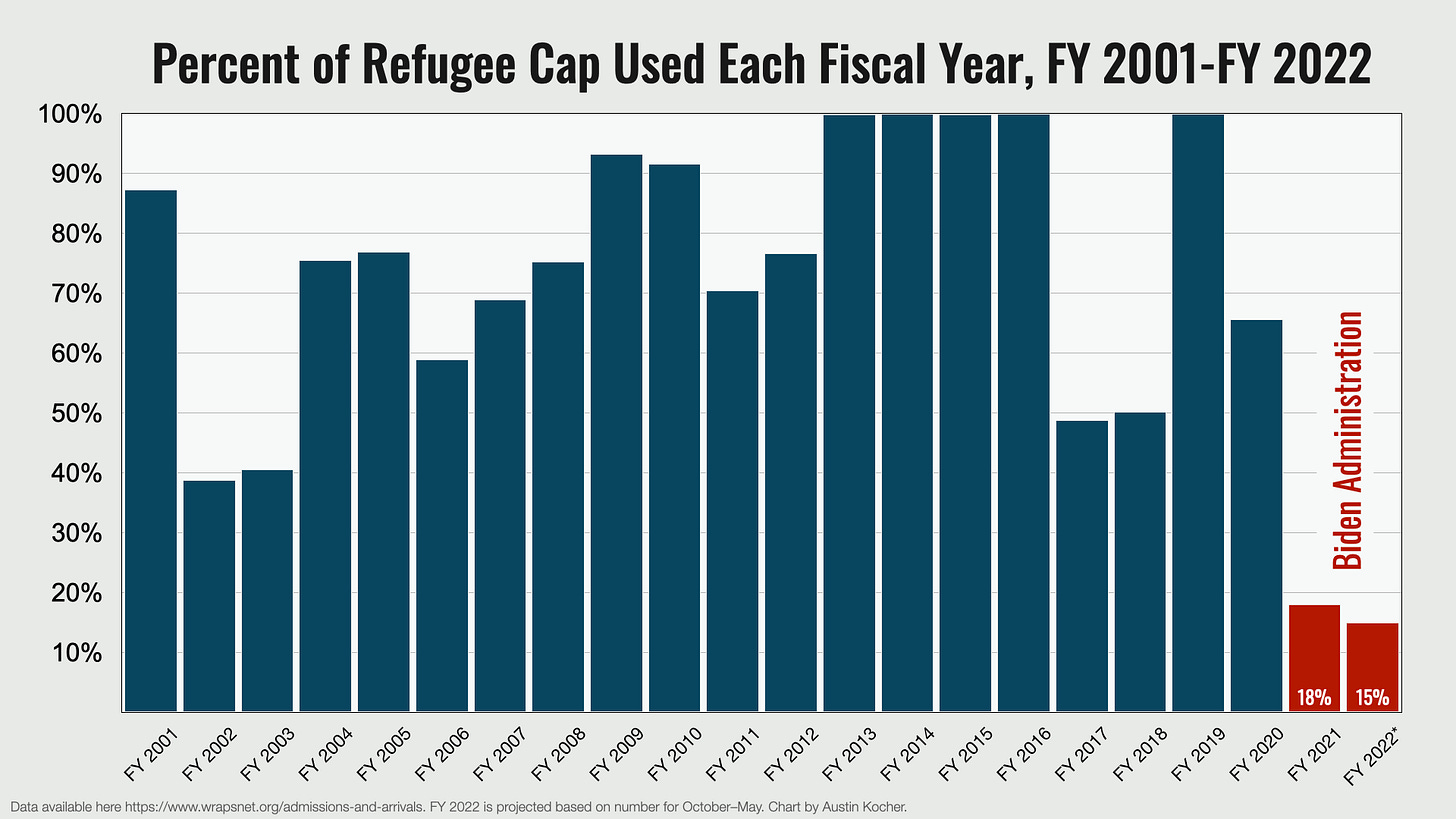Biden Administration on Track to Increase Refugee Resettlement This Year but Falls Far Short of Cap
The Biden administration is on track to increase the number of refugees admitted into the United States from about 11,400 last year in FY 2021 to about 19,000 by the end of this fiscal year in September. This is higher than last year, but still far below resettlement numbers in the past 20 years and also far below the refugee cap that the administration set for itself.
Shortly after taking office, President Biden announced an executive order aimed at “Rebuilding and Enhancing Programs to Resettle Refugees”. The use of the term “rebuilding” here is key to how the Biden administration has framed refugee resettlement. The Trump administration reduced the refugee cap to the lowest point in history in FY 2020 by reducing it to just 18,000, which cut federal staffing and cut funding to the national network of resettlement partners. The Biden administration has framed its own low refugee resettlement numbers as a consequence of the Trump administration’s dismantling of the system.
There’s no doubt in my mind that the Trump administration’s legacy is a big factor here, but I wonder how much the administration is using this factor as cover for other internal issues. I really do mean “wonder” because I don’t pay close enough attention to the everyday politics of the Department of State to have a more detailed picture. If you have insight or a link to more information, feel free to leave a comment.
The administration is aware that it will fall short. In May 2022, Julieta Valls Noyes who runs the Bureau of Population, Refugees, and Migration (in the State Department) told Foreign Policy that the administration is expected to settle some 20,000 to 25,000 refugees in total for the fiscal year. That may still be possible, but even at this reduced goal, it would still require the government to resettle more refugees each month than they have done so far this year.
One obvious caveat is that the US has taken in about 70,000 Afghans and plans to accept about 100,000 Ukrainians under a humanitarian program—two large groups that aren’t included in these numbers.
Despite these caveats, official resettlement numbers appear to remain relatively low in FY 2022, certainly compared to the refugee ceiling (or refugee cap) that is set by the president each year. The Biden administration used just 18% of the refugee ceiling in FY 2021 and is on track to use even less in FY 2022—just 15% of its 125,000 goal.
Another way to look at it is that the administration is on track to fall shorter of its mark in FY 2022 than in any year going back to 2001. I hesitate to say that the administration is “wasting” these refugee “slots” since the refugee cap is not really like the cap on certain visas. (That said, USCIS actually is wasting hundreds of thousands of green cards by failing to issue them before they expire.)
These graphics are based on public data from the Refugee Processing Center.
A note about the data: The refugee resettlement process, which relocates refugees from abroad to the United States, is different than the asylum process, through which migrants who are not able to go through the refugee screening process outside of the country, apply at the US border or within the country. Therefore, those numbers are not counted in refugee resettlement numbers here. If you’d like to learn more, here’s a short video that explains the refugee process.
Did you know? Although refugee migration has become increasingly politicized in the developed world, developing countries actually host the vast majority—an estimated 86%—of all refugees globally.
Spotlight on refugee scholarship: If you’d like to read more about the refugee system from a scholarly perspective, I highly recommend the work of Dr. Patricia Ehrkamp, a geographer at the University of Kentucky whose many recent works include the article “Trauma as displacement: Observations from refugee resettlement” as an introduction to a special issue on displacement for the Annals of the American Association of Geographers.
Coming up next. After a short diversion to discuss the new movie The Courtroom, about immigration court proceedings yesterday, and this post on refugee admissions, I will be returning to my ongoing discussion of ICE’s electronic monitoring program.


THANK YOU FOR READING!
If you found this information useful, help more people see it by clicking the ☼LIKE☼ ☼SHARE☼ button below.






